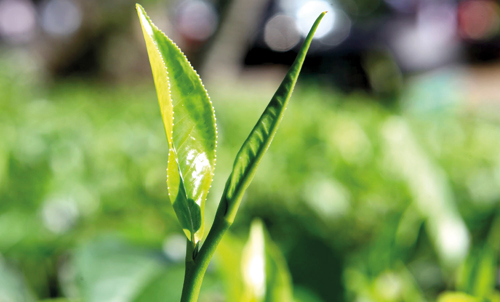“Triple T” in trouble
View(s):
Tea earnings might suffer due to the chemical fertiliser ban.
Textiles, tourism and tea are the most important commodities in our export mix which includes both goods and services. The three sectors alone account for more than half of Sri Lanka’s export income. Hit by the COVID-19 pandemic, the 19-billion-dollar export income of the country fell by US$6 billion in earnings last year.
Despite import controls, merchandise trade deficit has already increased by $439 million during the first five months of the year. Over 80 percent of our imports are intermediate inputs and investment goods; they are needed to sustain production, and thereby incomes and jobs. Any policy measure that limits the availability of intermediate and investment goods in the domestic market will have far-reaching long-term economic implications. Besides, with the rising oil prices in the world market the pressure on import expenditure is again on the rise. We spend 20 percent of our import expenditure on fuel, while the volume of fuel imports cannot be cut down.
Someone could argue that import controls may be directed at consumer goods, particularly of “luxury” types, according to an old definition. The most important import items that have been under import controls are personal vehicles; it might save about 4 percent of total import expenditure. If we bring home appliances too under import controls, then we might be able to save another 1 percent. Although some of the items in this consumer goods category are classified as such, when they are purchased for business purpose, apparently, they also do carry consequences on production, incomes and jobs.
It is in this context that I thought of bringing out a discussion on, not import controls, but on the challenges that the country has faced with our exports. I am looking at the most important export-trio – textile, tourism and tea.
Textile and garments
The largest single export item which brings about $5.5 billion export income as of 2019 is textile and garments. The sector has provided 350,000 direct jobs and another 1 million indirect employment. When Sri Lanka commenced production of textile and garments for exports to developed country markets, these exports were subject to quota restrictions under the Multifibre Agreement (MFA). While the international investors in the textile and garment sector moved around the then liberalising developing countries for orders to make use of the available country-quota under the MFA, the investors too looked for investment opportunities in developing countries. Nevertheless, the quota system also constrained the expansion of the sector beyond the limits of the quota, as a disadvantage.
As the MFA was phased out in 2004, the countries which were able to face the quota-free market competition benefitted, while others lost; I believe, Sri Lanka is one of these countries which benefited from the abolition of the MFA, although it was not each and every producer who faced the challenge successfully.
Soon after the abolition of the MFA, Sri Lanka faced the tsunami catastrophe in 2004 and was entitled to the European Union’s General Scheme of Preferences plus (GSP+), since its very inception in 2005. Under the scheme, Sri Lanka got quota-free and tariff-free access to the EU market. The GSP+ scheme covers two-thirds of tariff lines of the country or 7,500 export items, including textile and garments. The country lost it in 2010, regained in 2017, and is likely to lose it again in 2021.
To win or to lose
GSP+ is a “Special Incentive Arrangement for Sustainable Development and Good Governance”. There are only eight countries in the world as the exclusive beneficiaries of the GSP+ scheme – Armenia, Bolivia, Cape Verde, Kyrgyzstan, Mongolia, Pakistan and Sri Lanka. According to the strict eligibility criteria of the GSP+ scheme, a country should first be a “vulnerable developing country” with a non-diversified economy and low level of exports to the EU – all these indicate that the country should be a special category of the “poor”. Secondly, the country must have ratified and implemented 27 international conventions as specified by the EU.
With the impending loss of the GSP+ scheme, I wondered about two important questions related to its eligibility criteria. The first is that if we win it back, we naturally confirm that we are still a “poor and vulnerable” country! If we lose it as it already happened, we confirm that we are “incapable of doing” with what we have ratified for! Anyway, the answers to these questions are beyond the scope of our discussion today.
However, my second question cannot be ignored: In the midst of a foreign exchange problem, we cannot afford to lose the GSP+ which affects over 20 percent of our total exports that are destined to the EU market. We have already lost GSP+ benefit for another 10 percent of our exports to the UK market, due to Brexit. An alternative to the GSP+ scheme would be a Free Trade Agreement (FTA) with both the EU and the UK; many other counties in Asia opted for FTAs with them without the risk of losing their trade benefits. But Sri Lanka did not choose FTAs either.
Tourism sector
The tourism sector recorded a healthy growth since the end of the war in 2009 and contributed to over $4.3 billion foreign exchange earnings in 2018, which was over 50 percent of our services exports. The sector has already created nearly 400,000 jobs directly and indirectly, serving over two million tourists arriving annually.
 Unlike many other export sectors, the tourism sector is different. As an export commodity, it is a “package” comprised of various goods and services so that the sector has multiplier effects through its numerous backward linkages. On the “bad side”, unlike other sectors the tourism industry is highly “fragile” as it over-reacts to security and health conditions both internally and internationally. The countries which tend to over-depend on the tourism industry are, therefore, highly vulnerable to both internal and external shocks affecting the tourism industry.
Unlike many other export sectors, the tourism sector is different. As an export commodity, it is a “package” comprised of various goods and services so that the sector has multiplier effects through its numerous backward linkages. On the “bad side”, unlike other sectors the tourism industry is highly “fragile” as it over-reacts to security and health conditions both internally and internationally. The countries which tend to over-depend on the tourism industry are, therefore, highly vulnerable to both internal and external shocks affecting the tourism industry.
Even before COVID-19, the Easter Sunday terrorist attack in 2019 had caused severe damage to Sri Lanka’s growing tourism industry. According to the analysis of “real time” global travel patterns carried out by the “ForwardKeys” on the basis of over 17 million flight bookings a day, cancellation of tourist bookings in Sri Lanka surged over 86 percent within three days after the Easter Sunday attack.
The COVID-19 pandemic has knocked down the global tourism industry since last year. As a result, tourist arrivals fell down to just over 500,000 in 2020, while tourism earnings dropped by over 80 percent. The losses are not only for the foreign exchange earnings, but also for the people engaged in the industry through income and job losses.
Tea sector
Historically Sri Lanka enjoyed a comparative and competitive advantage in the international market, particularly, over its brand name “Ceylon Tea”. Most of its glorious status is already gone due to new competitors in the market and the change in demand patterns, as well as politics more than economics that governed the elements of the local tea industry.
In spite of all that, tea is still important in Sri Lanka in terms of its economic contribution; it’s not because of the “importance” of tea per se, but because of the “unimportance” of the growth of other sectors. If not for that matter, even though the tea sector would have flourished and grown, its share of contribution would have dropped significantly. It still provides job opportunities, directly or indirectly, to over 1 million people. Being the country’s second largest export item after textiles, tea exports generate over $1 billion foreign exchange.
According to industry sources, the latest blow to the tea industry is the policy decision on the fertiliser ban. I am not an industry expert to comment on this issue. I also do not know whether Sri Lankan tea would emerge as a global organic Ceylon Tea brand. However, potential repercussions of the current blow to the tea industry squeezing our foreign exchange constraint seem substantial.
(The writer is a Professor of Economics at the University of Colombo and can be reached at sirimal@econ.cmb.ac.lk and follow on Twitter
@SirimalAshoka).


